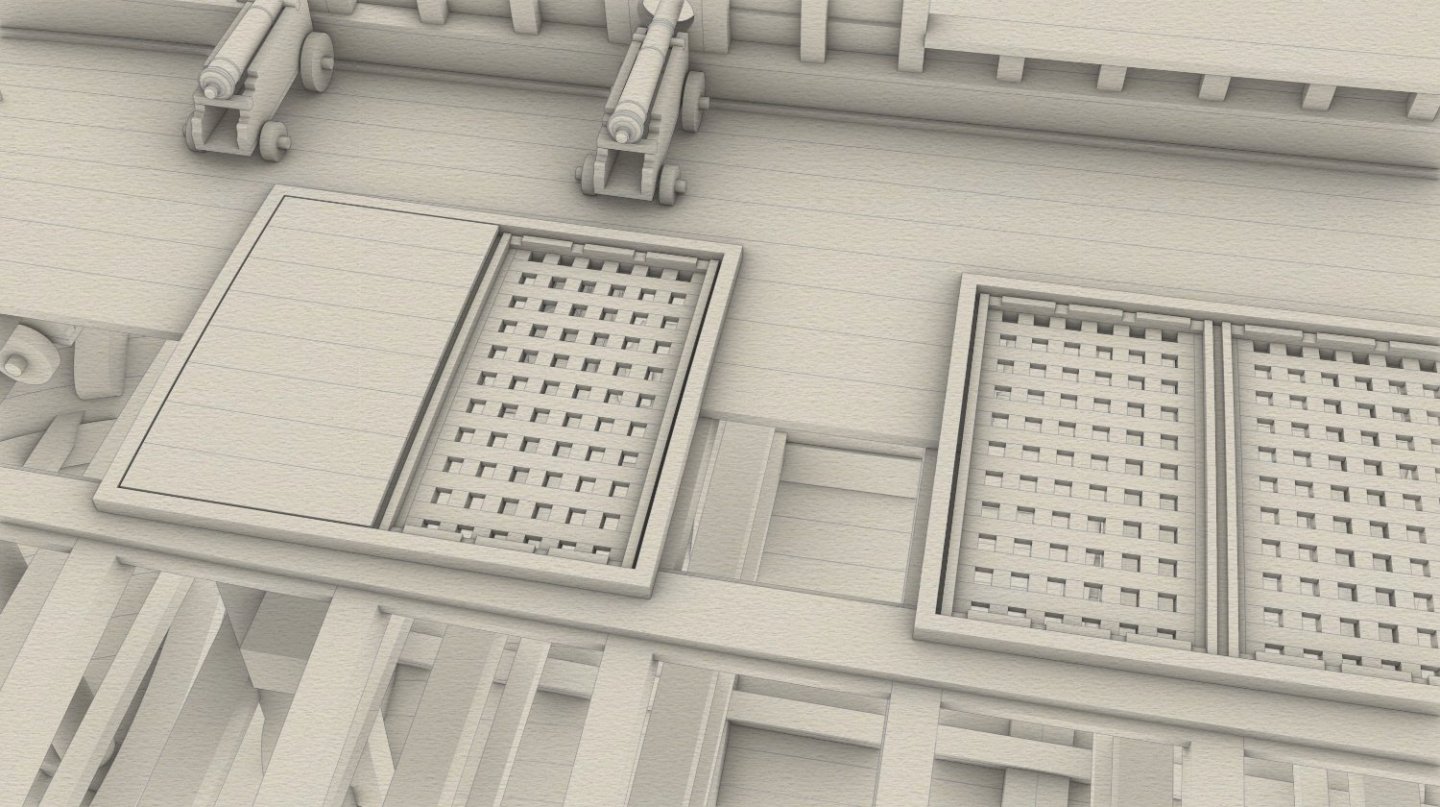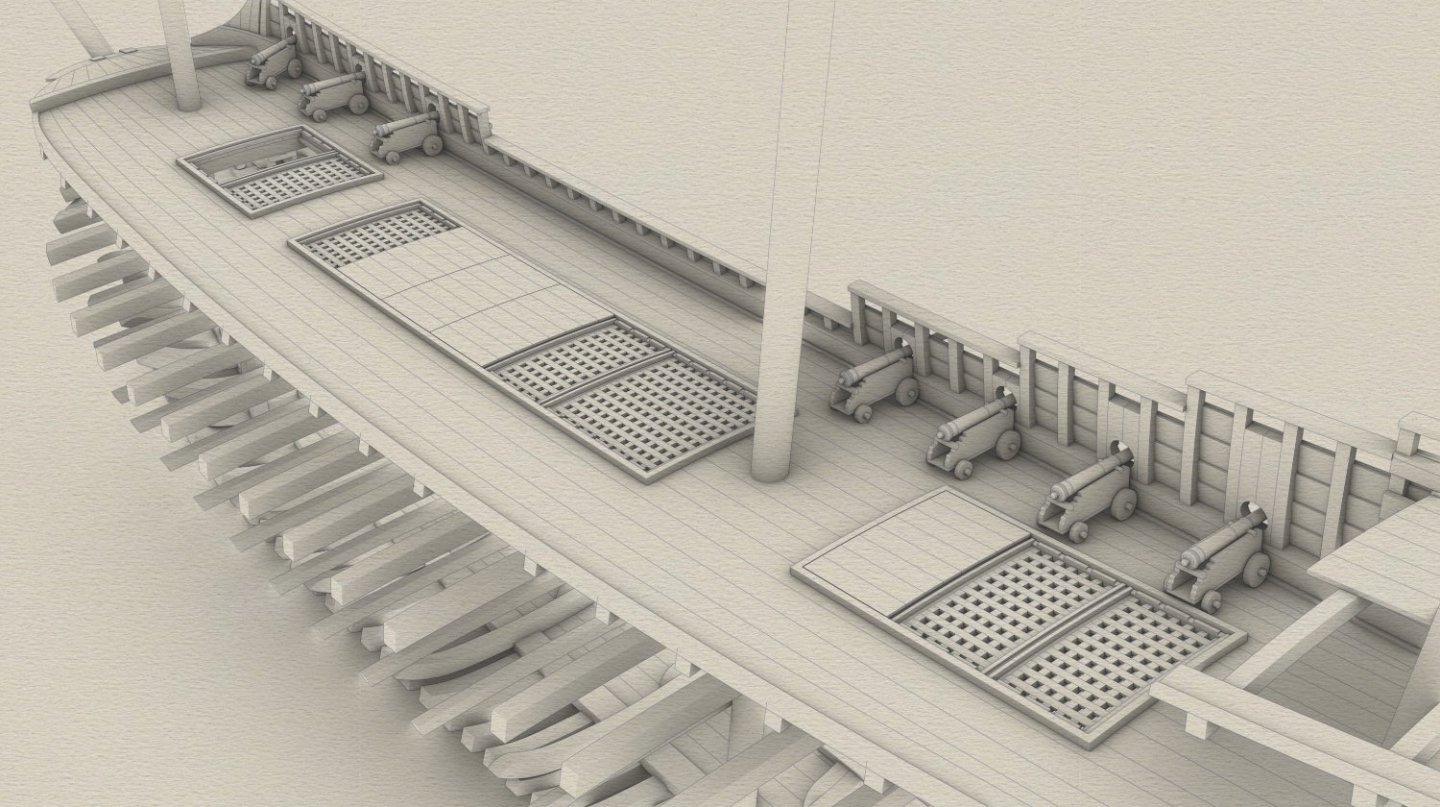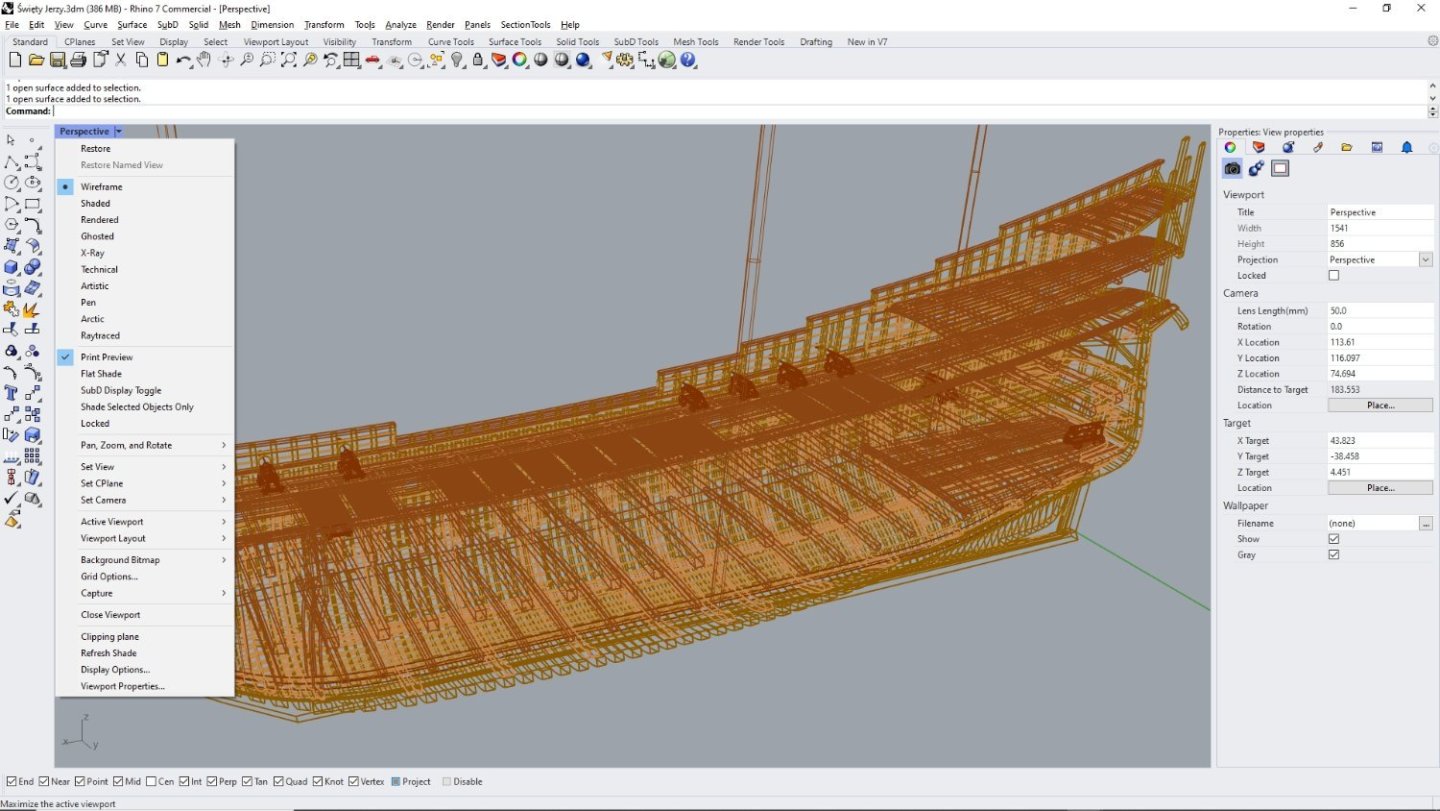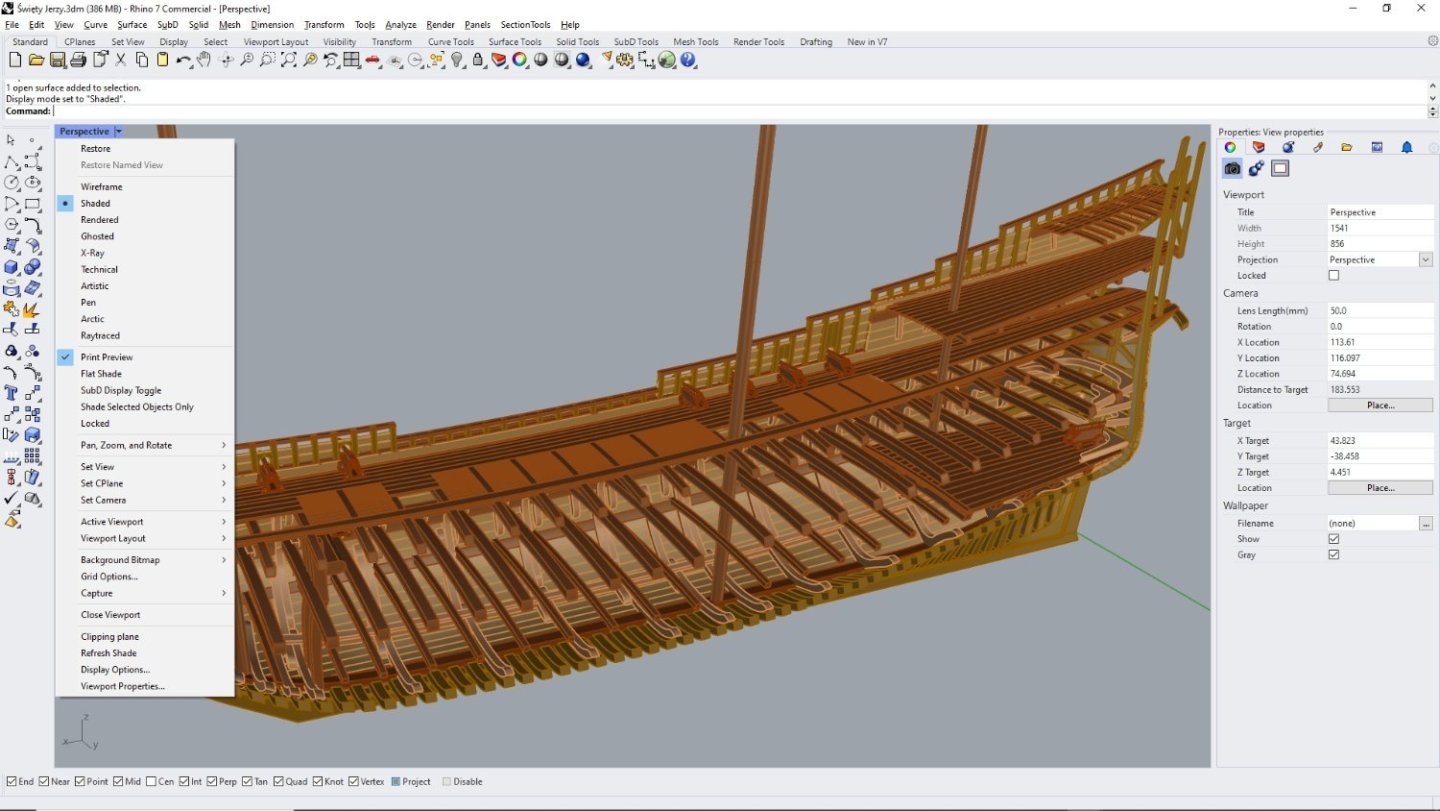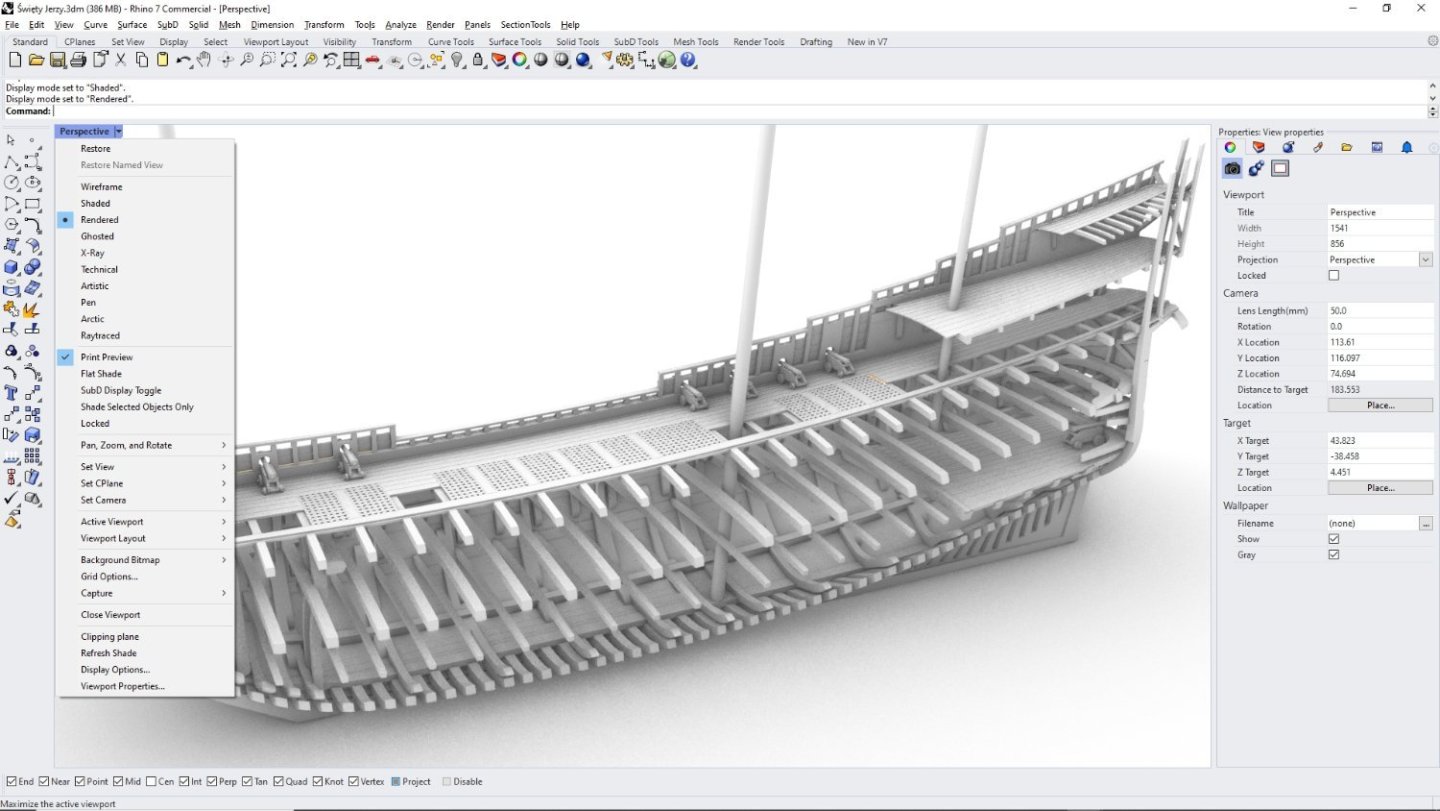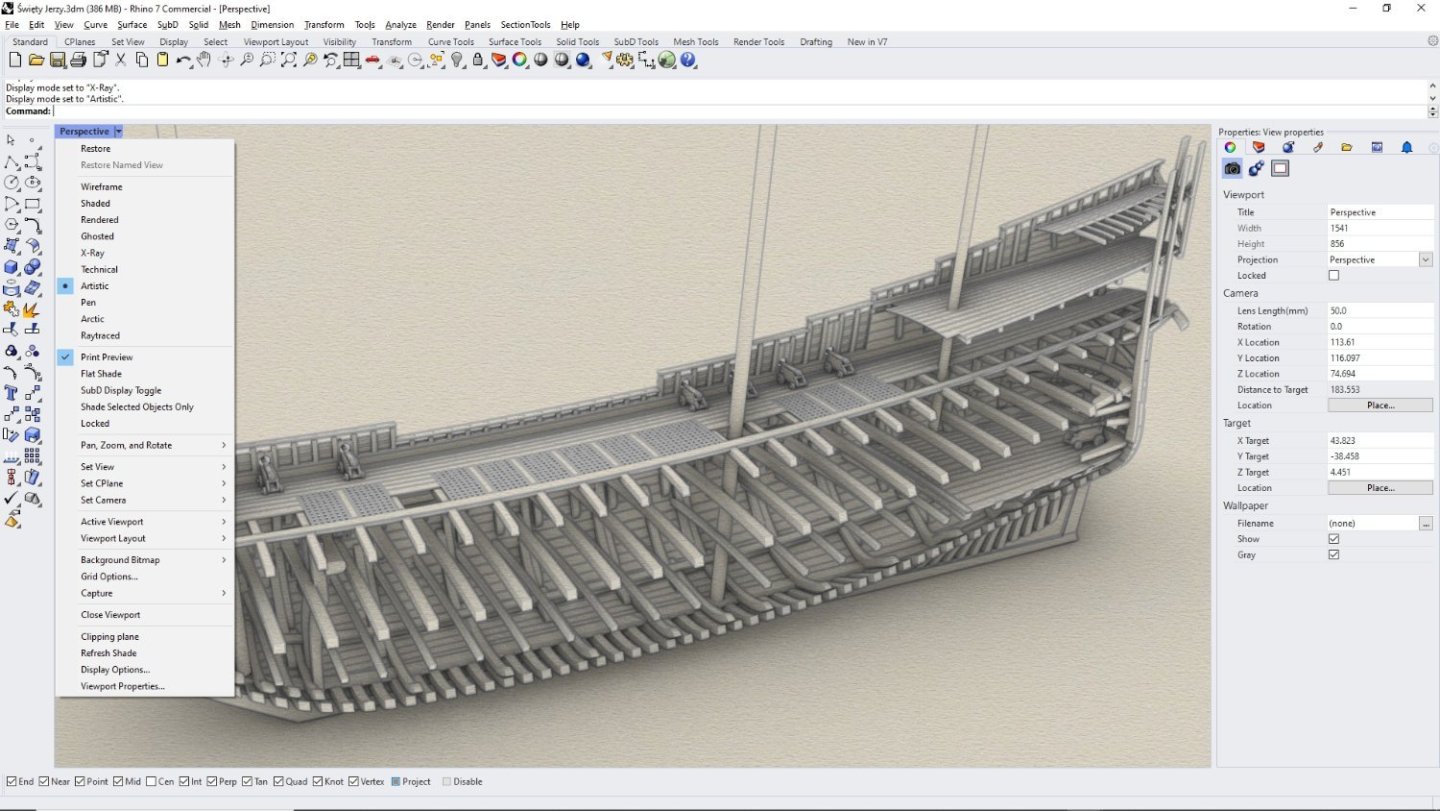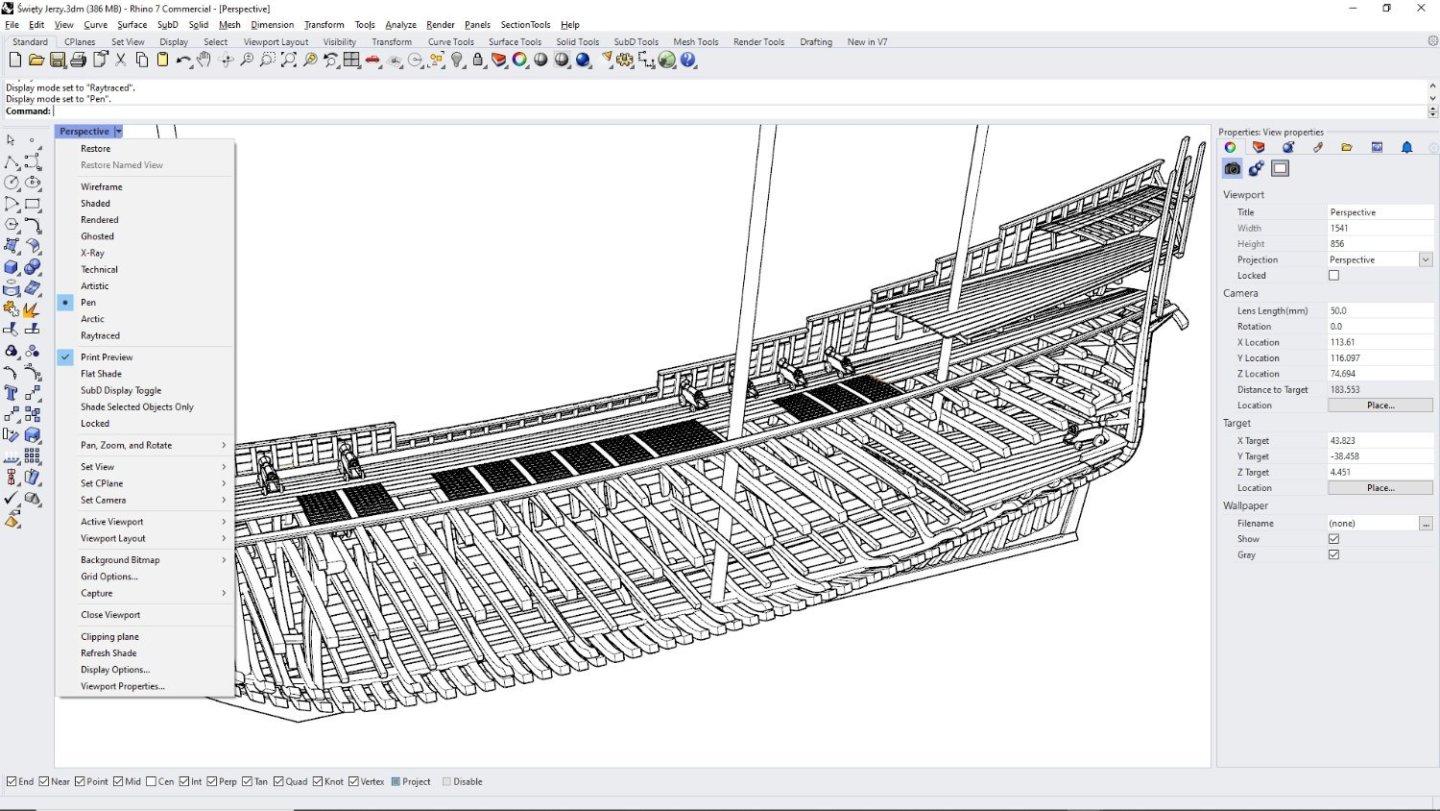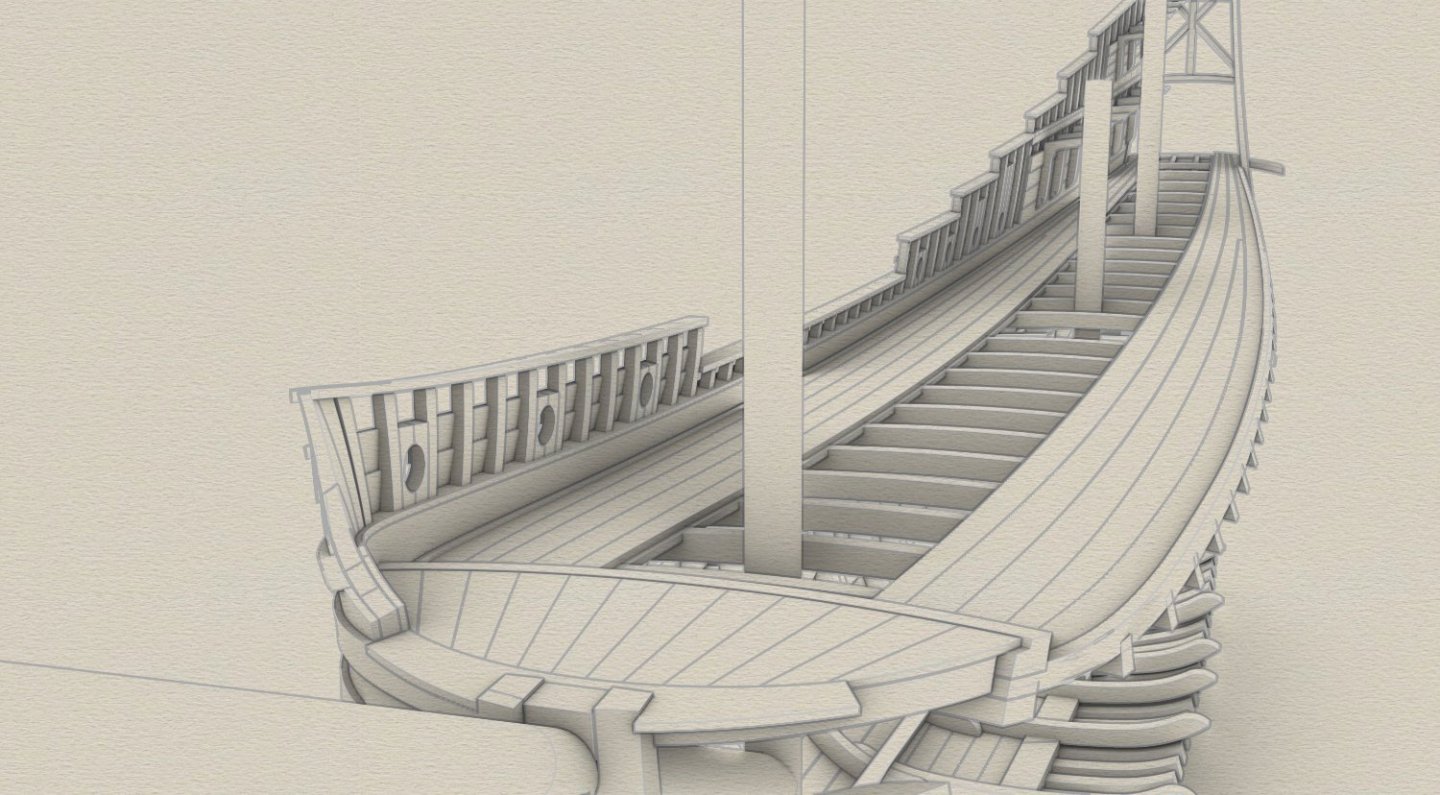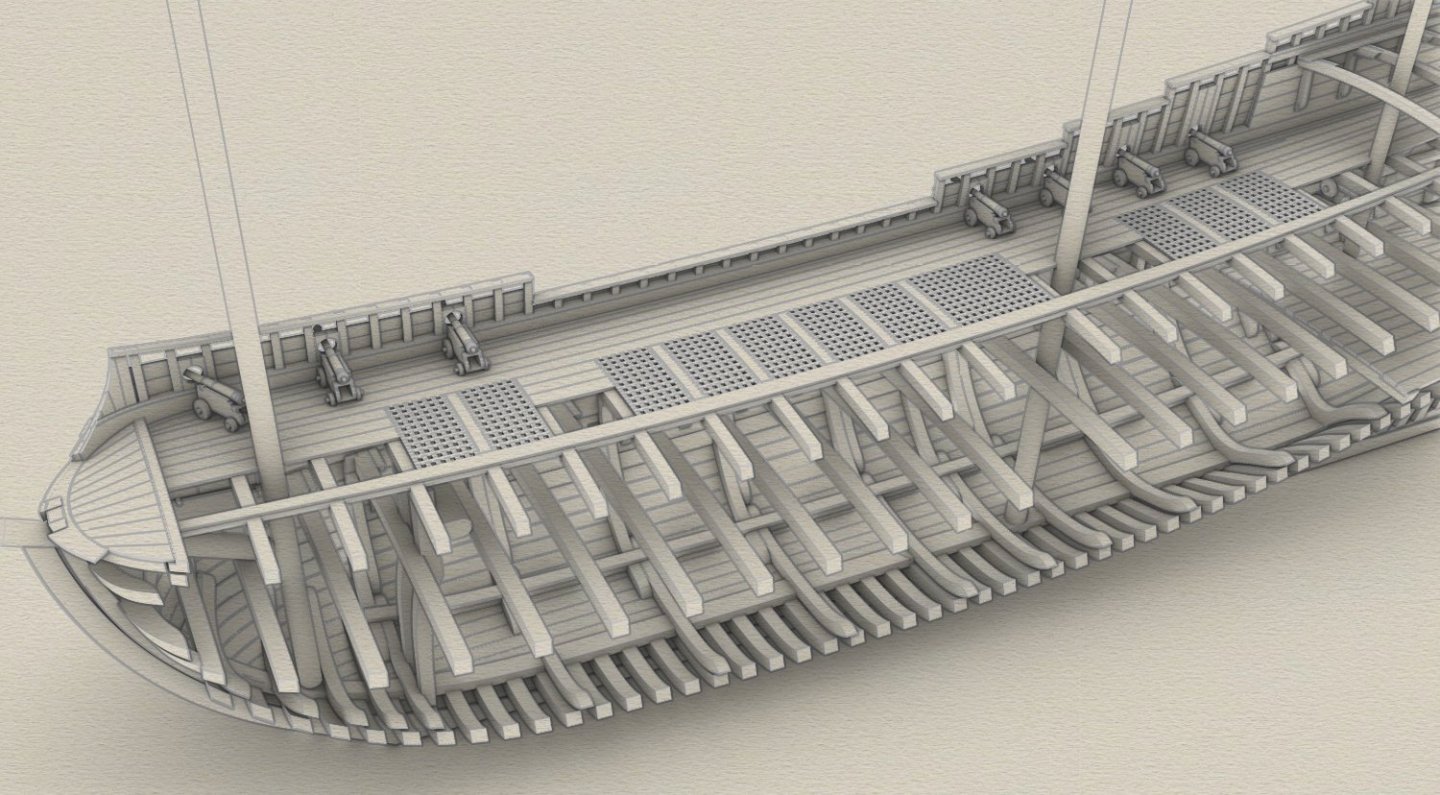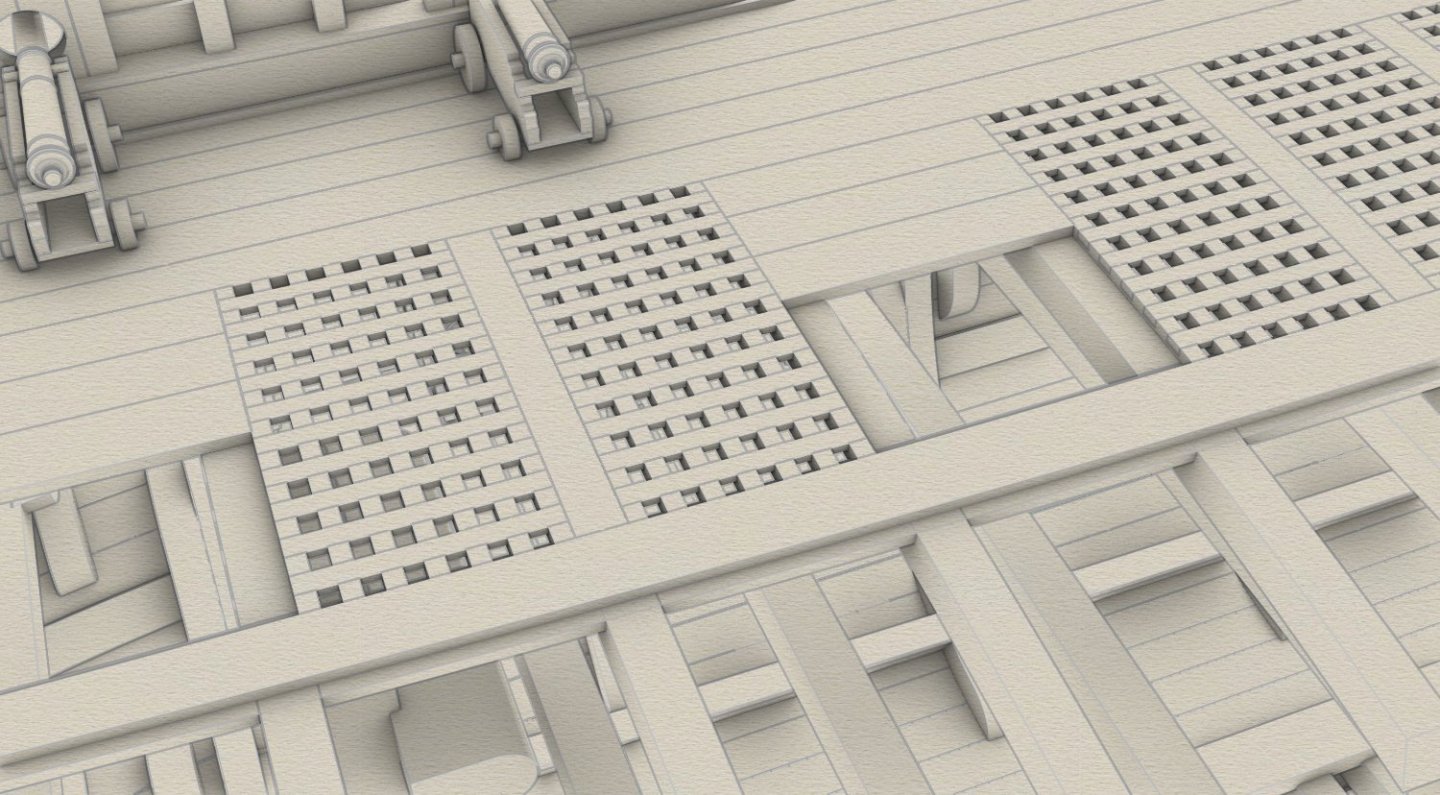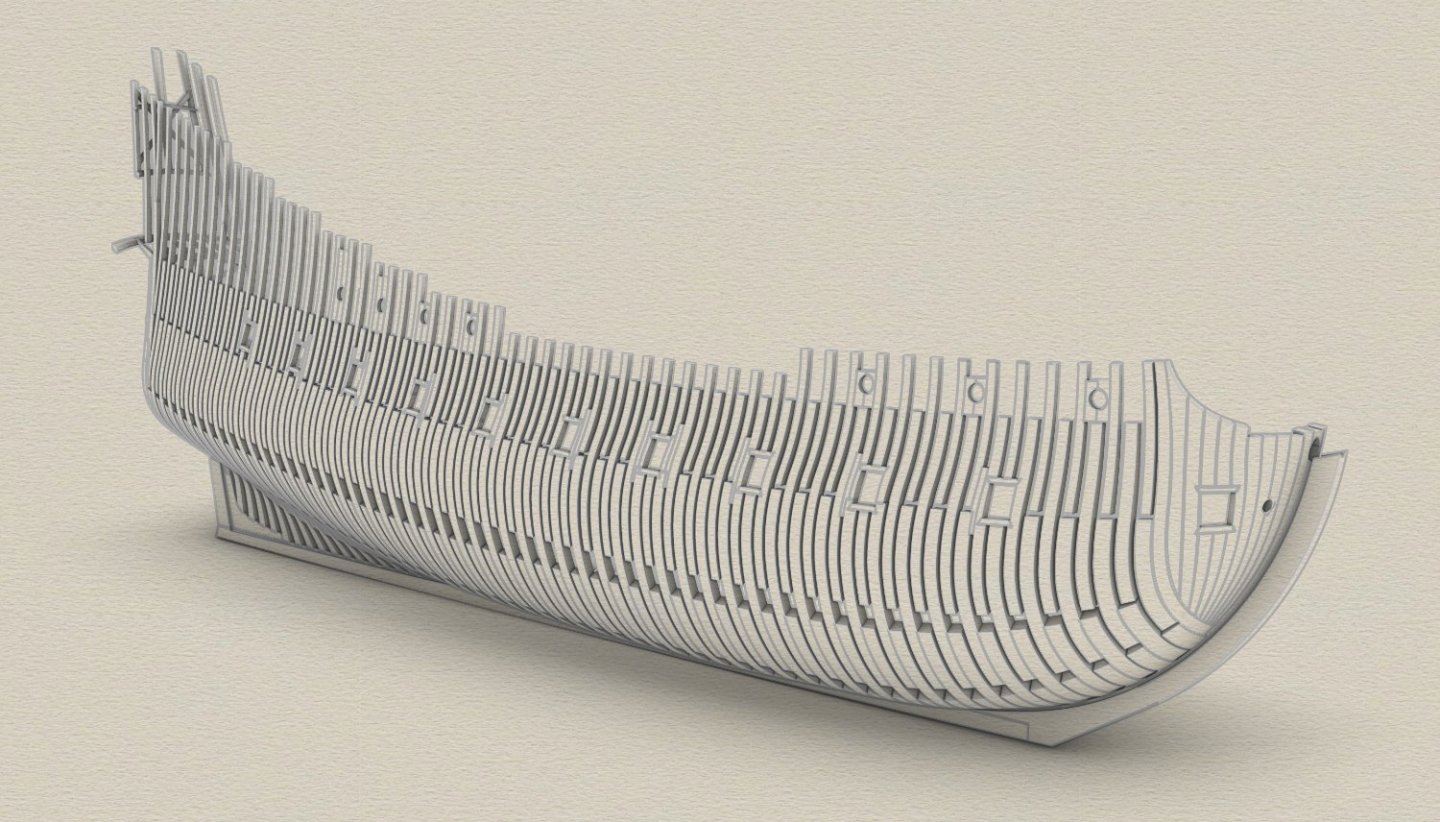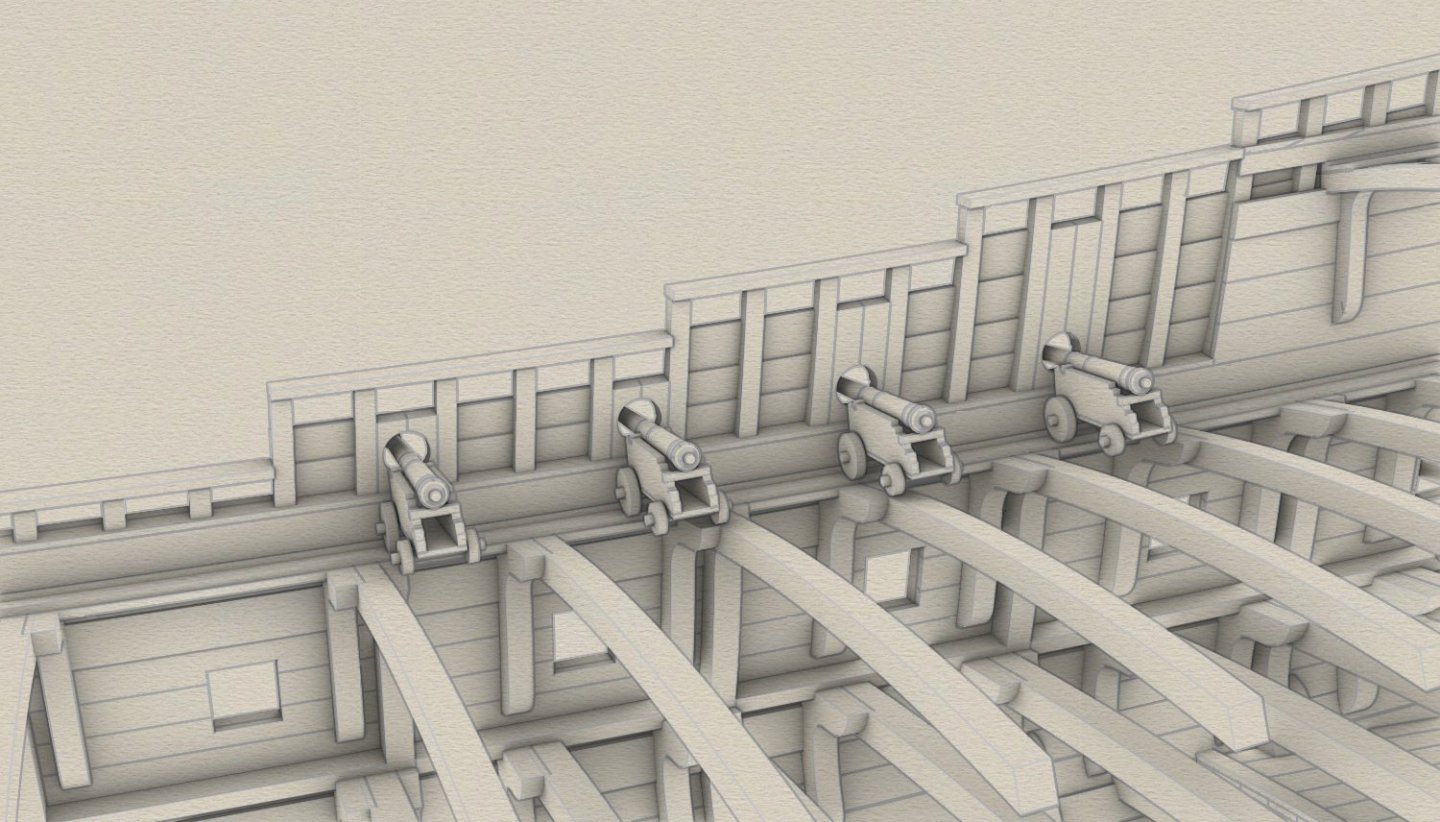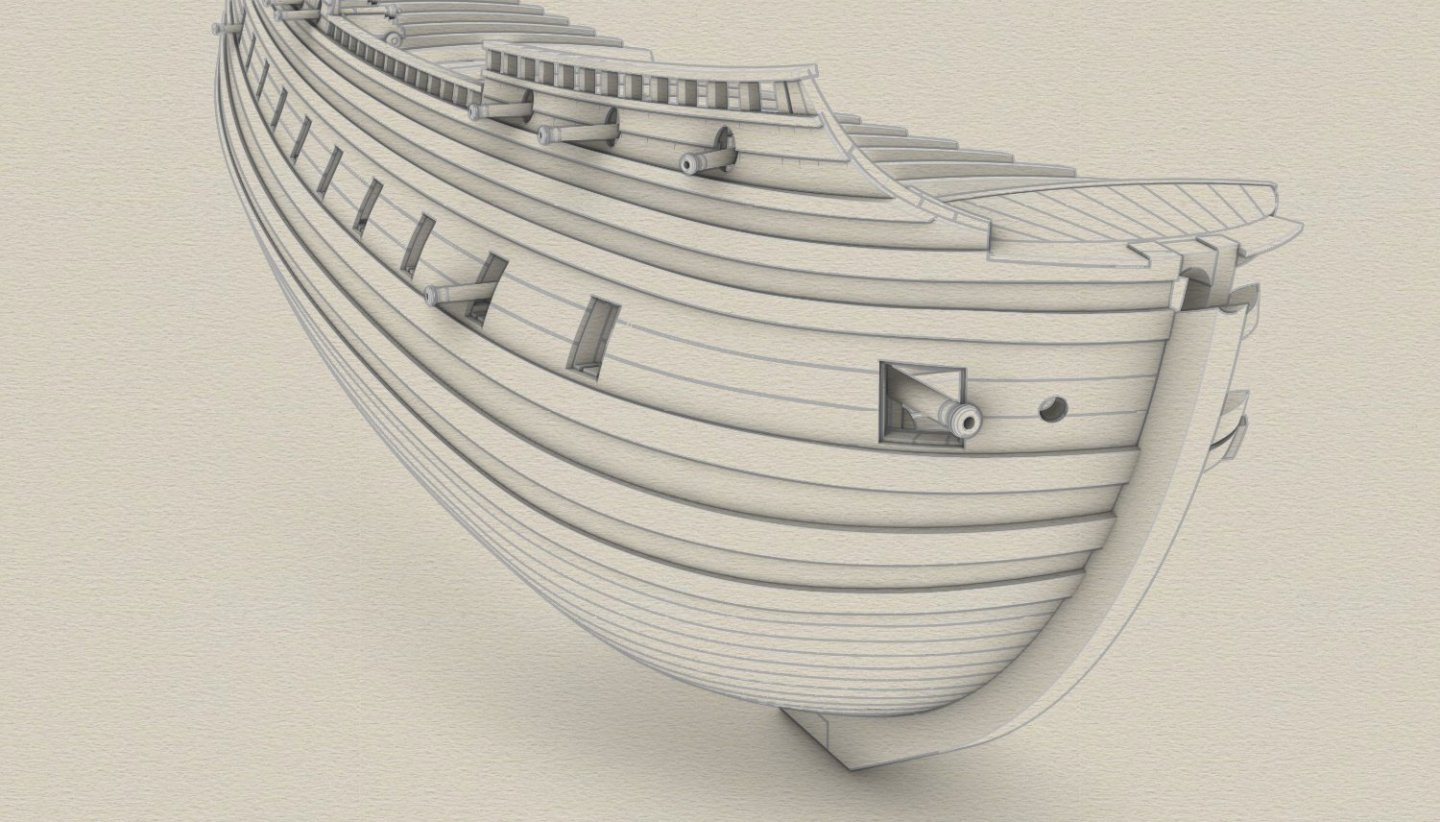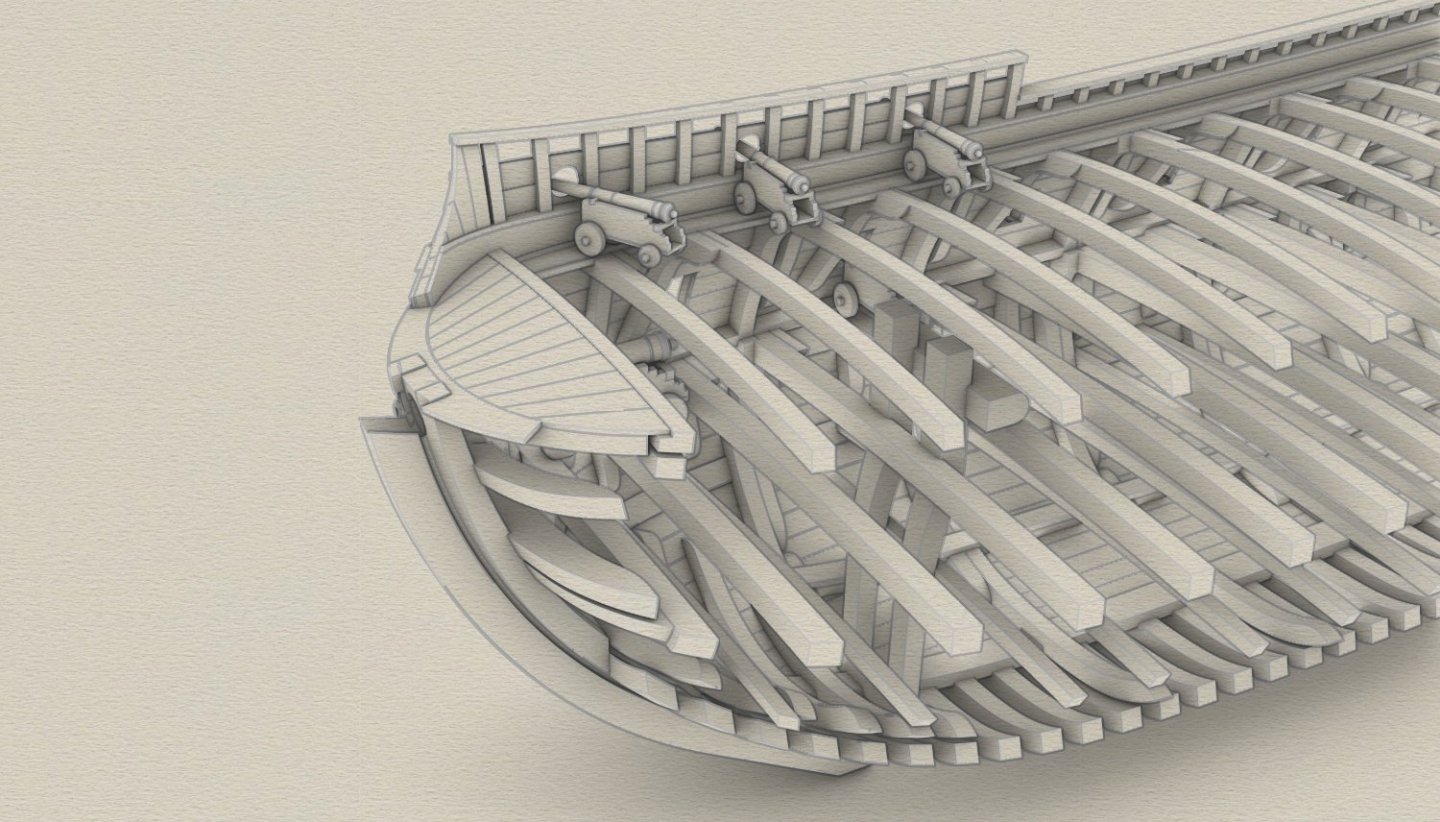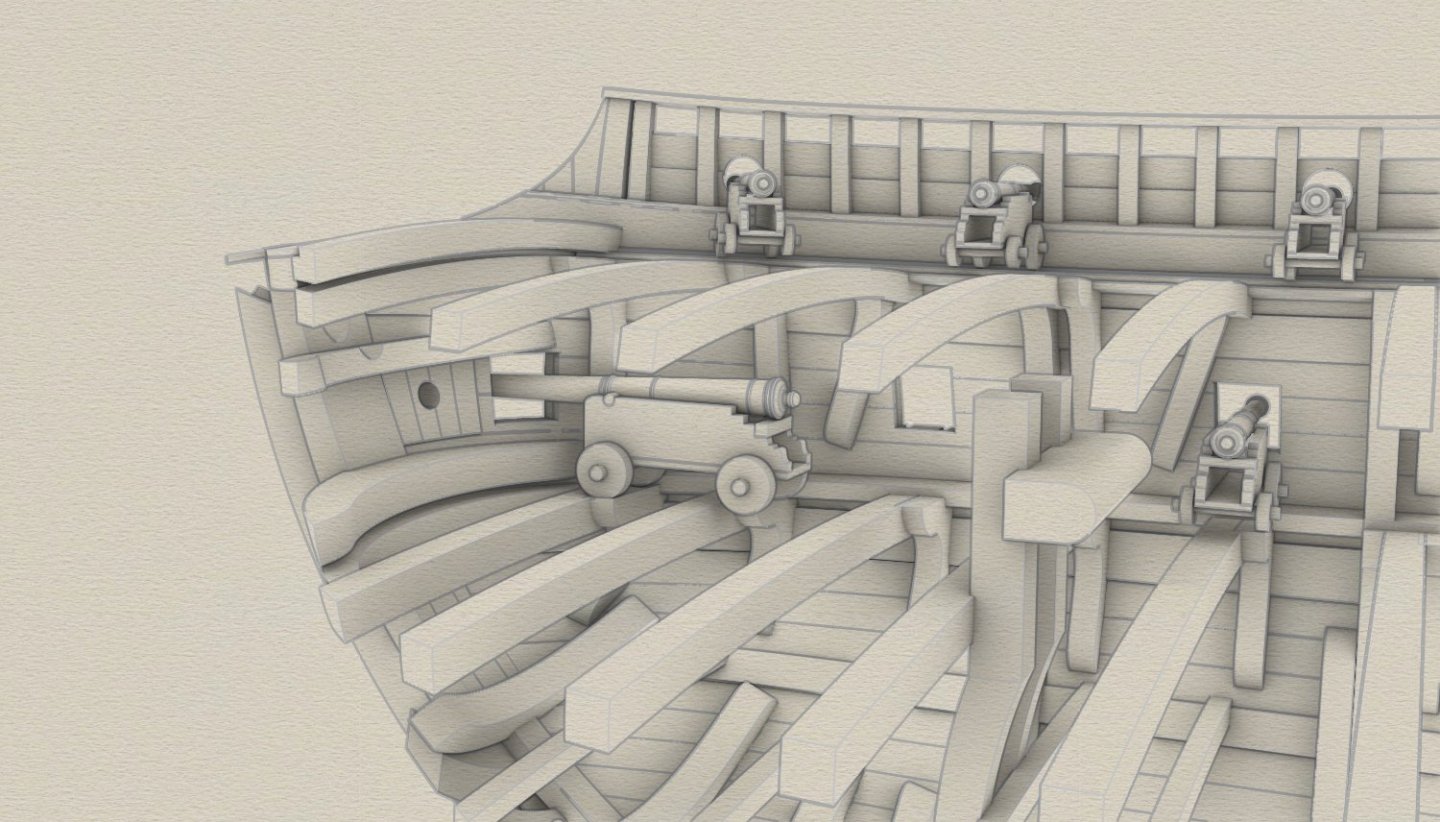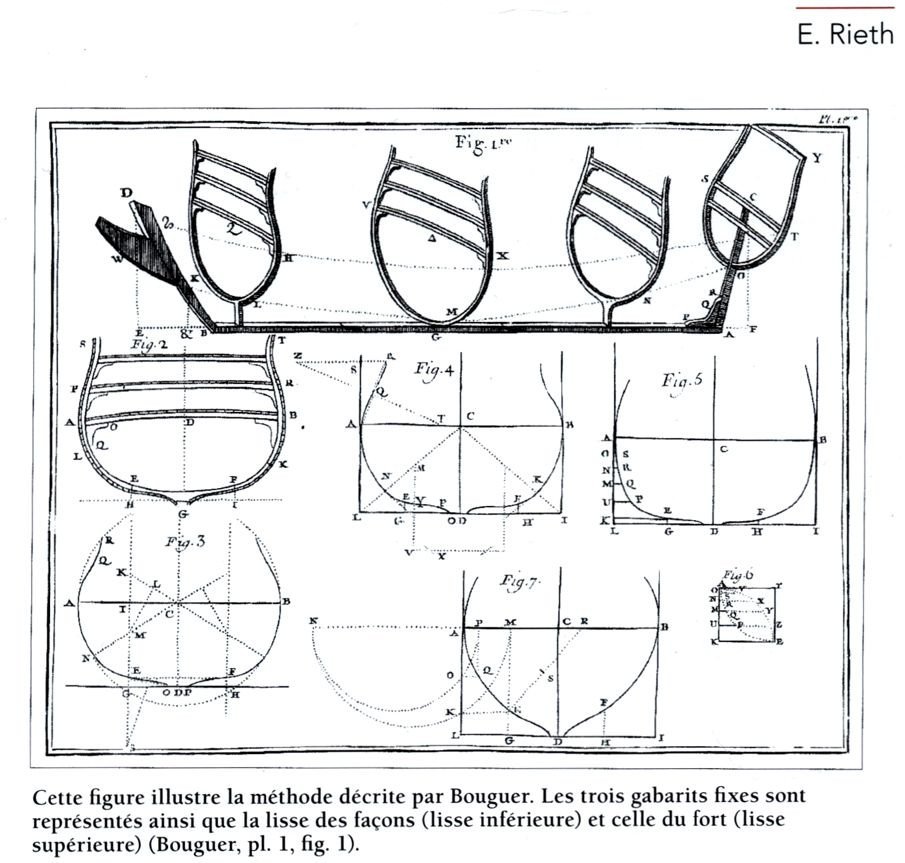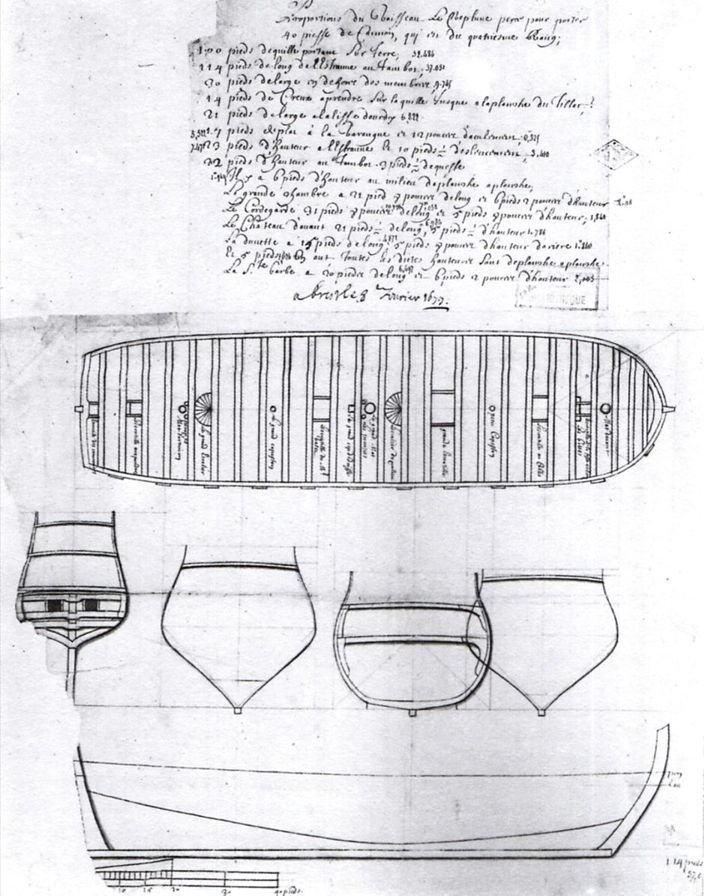-
Posts
987 -
Joined
Content Type
Profiles
Forums
Gallery
Events
Everything posted by Waldemar
-
That's right. There are several Display Modes in Rhino to choose from, some more suited for modelling work, and other helpful for presentation purposes (sorry for the banality). Below I have included a few samples I use most often. Trying not to use external plug-ins to the Rhino, and fortunately the number and look of Display Modes available already in Rhino is more than enough for my needs. Wireframe: Shaded: Rendered: Artistic: Pen:
-
... just started the upper deck. It is called "koebrug" in the fleet inventory, so I have designed this deck as heavier than "bovenet" (very light deck), and – at the same time – lighter than a regular deck. In practice: a lot of gratings, but still able to carry a few small-calibre artillery pieces.
-
Many thanks for your comment. Building the wooden model by two professional modellers (for the museum exposition) should start within weeks, even without waiting for the completion of the ship’s documentation. Also, in order to speed up the work, the plank-on-bulkhead construction is planned for this very first model. Perhaps I would be allowed to attach some photos of this work-in-progress too. Just now I am preparing section lines of the hull for them.
-
Right, in general, you are correct – the guns were mounted more or less perpendicular to the ports. The exception, however, was the chase ports, which were even made a little wider than the rest, so that the heaviest and tactically most important guns could be directed right forward. This is explicitly recommended (as I recall) in one of the English 17th century shipbuilding treatises. My explanation for this is that it would be impossible to yaw both ways when sailing closed-hauled against the target about to be boarded. It would be perhaps no time for such manoeuvres too, as the artillery fire was opened at the last moment (usually at the musket range, ie. 75–150 m) in order to reduce the risk of missing the target. And we are still at the period of boarding tactics – typically just one artillery salvo and then immediate grappling, at least by determined combatants (Armada campaign with windward English vessels refusing to board opponent ships is not quite typical for this era).
-
Philemon, There is really not much risk of being battered by stating that many or even most methods of building ships in the early modern era had more or less common features, as this is already a long, firmly established view among notable experts. I heartily agree with this conclusion and have never said that all "these methods are very different from each other". I am very sorry my words were over-interpreted. On the contrary – reading more and more on various shipbuilding methods it becomes quite clear that beside any differences, they share many similarities, (be it features, approaches, procedures or structural details), and in many ways. This is why it is always beneficial to see any particular case in a wider context, not just through the content of any one book, however comprehensive. The frame-led method as described by van Yk (also called "elementary method" by Jean Boudriot) is a perfect case in point. Personally, I regard this method as an elaboration of the "pure" shell method and, at the same time, an important step in developing more advanced, already graphical methods of designing ship's hulls. For a number of reasons I have elected not to explain the very basic terms like "bottom-first" or "frame-first", nor to enter the construction/building details, as these are already quite competently explained in existing works. You, and perhaps other readers, may be interested in consulting works such as (and this is only a small selection): – A. Hoving, A. Lemmers, In tekening gebracht. De achttiende-eeuwse scheepsbouwers en hun ontwerpmetoden, 2001, – B. Ollivier, D. Roberts (ed. and trans.), 18th Century Shipbuilding. Remarks on the Navies of the English & the Dutch from Observations made at their Dockyards in 1737, 1992, – A. Hoving, Nicolaes Witsen and Shipbuilding in the Dutch Golden Age, 2012. From the conceptual point of view, the most enlightening works, devoted to the frame-led method (in effect, the same or very similar to that described by van Yk), are two papers by the top authority on the subject: – E. Rieth, Une autre méthode de conception des «anciens constructeurs», celle du maître-gabarit, du couple des estains et des lisses, Neptunia 298, and – E. Rieth, Une autre méthode de conception des «anciens constructeurs», à l'aide d'un maître-gabarit, de gabarits des couples de balancement et des lisses de construction, Neptunia 299. Here only the translation of two short fragments taken form these papers: „[Besides,] two other methods not based on the use of plans are mentioned by two authors representative of the 18th century scientific thinking on nautical matters: Spanish Jorge Juan and Frenchman Pierre Bouguer [...]", and "In effect, that was in the shipyard, during actual construction, that the geometry of the [hull] shape was defined". Nevertheless, if you prefer to consult the original sources, here their titles: – G. Juan, Examen maritime théoretique et practique, ou traité de mécanique appliqué à la construction et à la manoeuvre des vaisseaux et autres bâtiments, 1783 (French translation), – P. Bouguer, Traité du navire, de sa construction et de ses mouvements, 1746. Below is an illustration taken from the work by Pierre Bouguer, depicting the principal elements of the frame-led ("elementary") method, employed also by van Yk. Waldemar
-
Well, I think such a steadfast attitude of Ab Hoving is quite justified provided it concerns conceptual aspects of ship design (hull shape). Let me remind that Ab's main focus is on the shell (bottom-first) method described in Witsen's work, often referred to as the Dutch method (an obvious mental abbreviation, as different techniques were used in the south of the Netherlands - i.e. quasi skeleton methods; furthermore, shell methods could be also developed and used in other parts of the continent, notably in northern Germany – see, for example, cog's construction). But back to the point. The very nature of the shell method actually precludes the use of theoretical line plans. I would propose an experiment here (and experiments are inherent part of science) – an attempt to build a ship (or a model of a ship) using the shell method, conforming to the theoretical hull lines made beforehand and within acceptable accuracy. I would not believe it is possible until I see the opposite. Still in the second half of the 17th century, there was much consternation among shipwrights in the French service, including those of Dutch origin, when asked by the authorities the first time for design draughts. This is an example of what was then produced: Firstly, it may be connected with the frame-led method as described by van Yk, rather than with the shell method. Secondly, is this drawing strictly defining the whole hull shape? The answer is no, especially if considering that location of both tail frames could be adjusted along the keel during actual building. Thirdly, were such rudimentary sketches really necessary for experienced shipwrights? Don't think so. Waldemar
-
Philemon, Published works in the most major European languages on designing (or shaping) the hull bodies in the early modern era, be it graphical or non-graphical, are already abundant, and it is simply not possible to repeat their content here. It is neither practical to list all or even most of them. However, one of the best quite detailed modern summaries on this theme, which you may try, are provided by Jean Boudriot in the chapter “Méthodes de conception” in his book “Les vaisseaux de 50 et 64 canons” and in the paper “La conception des vaisseaux royaux sous l’Ancien Régime” (Neptunia 169, 1988). There are many, many other available sources, works and evidence, and there is no doubt that ships of all sizes, built to the skeleton method principle, could be created using non-graphical methods, i.e. without scale line plans made before the actual construction. And in the shell method of construction, as described by Witsen, even trying to work to any such prepared line plans would be no-go. In other words, shell method of construction and scale line plans are simply not compatible. Hence the importance of the shape of the rabbet, which governed the run of the planks. To some extent the shape of the rabbet was also important in the frame-led method described by van Yk, as there were too few pre-erected frames to govern the run of the garboard strakes properly. The most enlightening work on the actual building practices in the early modern era is perhaps the manual by Edmund Bushnell, “The Compleat Ship-Wright”, published in 1664. While partly graphical method for defining the hull body is presented in this manual (meaning the author applies only some elements of scale line plans), with some ingenuity and known at the time transformation tools/procedures, the described method of shaping the actual wooden moulds and frame parts can be also implemented to the non-graphical methods, directly on the shipyard ground. Best, Waldemar
-
Hello Philemon, Very interesting topic. Let me add to your remarks my three cents. By the time the Swedish subject Ake Rålamb wrote his illustrated booklet in 1691, various shipbuilding methods were used or known in Sweden, i.e. skeleton methods (frame-first and frame-led) and shell method (or perhaps more precisely: bottom-first). From about the middle of the 17th century, the Swedish king’s ships (men-of-war) were being increasingly designed and built using skeleton methods by English “imported” shipwrights (mainly Sheldon family). These English shipwrights certainly used scale-drawings in the construction process. Most importantly, such drawings strictly defined the body shape of the ship’s hull. My current understanding is that scale diagrams or sketches made with the only intention of just defining the layout of internal devices or structures could be made in all these methods, but such diagrams are of secondary importance, as they do not define the most important conceptual features of the ship (i.e. hull shape). In fact, it is hard to imagine the marriage of scale design/conceptual drawings with the bottom-first method as described by Witsen. Such drawings would be neither of much use in the frame-led method as described by van Yk. They could be even dispensed with in many of the known frame-first methods, as described in the Mediterranean or Atlantic sources, just full-scale tracing on the shipyard floor was clearly considered enough. Waldemar
-
Your fine model showing the internal structure of the ship, particularly at a large scale, is a pleasure to look at. And for me, it is equally true for those without more or less distracting details like all kinds of ornaments, colours etc. Artistry in pure structure...
- 7 replies
-
- Endeavour
- cross-section
-
(and 1 more)
Tagged with:
-
.thumb.jpg.c6343966b029e7941df5b987d129aac6.jpg)
Various applications of 3D drawing
Waldemar replied to 3Dships's topic in CAD and 3D Modelling/Drafting Plans with Software
Thank you for the information. I asked about the program you use to create 3D model/objects, as I am just using Rhino myself. Unfortunately, this program (which I like nevertheless) has a tendency to produce much rubbish when generating 2D sections and projections from 3D objects, and I will have to deal with this particular problem soon. Maybe you have some suggestions on this particular issue. In short – how to create (in Rhino) in both exact and hopefully easy way 2D sections and projections from 3D objects, while retaining its vector character (as opposed to bitmap graphic). And these are ultimately needed for "classical" modeller's draught.- 39 replies
-
.thumb.jpg.c6343966b029e7941df5b987d129aac6.jpg)
Various applications of 3D drawing
Waldemar replied to 3Dships's topic in CAD and 3D Modelling/Drafting Plans with Software
Very attractive renderings. Just curious, what software did you actually use for both 3D modelling and for visualisations?- 39 replies
-
.thumb.jpg.c6343966b029e7941df5b987d129aac6.jpg)
rigging to the French parrel, late XVIII C.
Waldemar replied to Dziadeczek's topic in Masting, rigging and sails
My pleasure. Boudriot's description of this detail is taken almost verbatim from "Encyclopédie methodique. Marine" (1783) and "Traité pratique du gréement des vaisseaux et autres batiments de mer" by M. Lescallier (1791), so it is unlikely to be his imagination. Besides, the fixed nature of this fitting on French ships' top yards is also confirmed by historic models in the Maritime Museum in Paris. So, I think you may be quite sure of it... -
.thumb.jpg.c6343966b029e7941df5b987d129aac6.jpg)
rigging to the French parrel, late XVIII C.
Waldemar replied to Dziadeczek's topic in Masting, rigging and sails
Hello, I can make some scans from 'Modeles historiques. Museé de la Marine", vol. I and II, but this is not really necessary. If you have the third volume of Boudriot's "The Seventy-Four Gun Ship", you will find all the information there. In addition to the drawings (in the French version, Fig. 296 and 297), find a detailed description of this detail (next to Fig. 295 in the French version). In short, the ends of the parrel-ropes are just wounded two or three times around the yard and permanently fixed in front of it, with no possibility of (quick) loosening or tightening. Cheers -
Good summary Jaager. In this context, it will perhaps not be out of place to mention a surprise I had recently when comparing two French works on shipbuilding. Both works from the late 17th century and both about warships. Both describing the same class (size) of ship built in government shipyards. But one in the Mediterranean tradition and the other in the Atlantic one. It turned out that many, even the most important parts of the hull skeleton have completely different scantlings. So what can be expected from practices in private shipyards?
-
True. Written works such as those by Bushnell, Sutherland or Chapman are more concerned with shaping the hull bodies rather than timber scantlings. Shipwrecks are too scanty and even somewhat unsuitable for systematic data to be obtained. And each private shipyard or shipbuilder could have its own idiosyncrasies. Possibly extant contracts could be explored here, but this could call a decade lasting research, and with no certainty of securing comprehensive data. One would say, a hopeless task... Actually we are left perhaps with Steel's works only, and I believe you could relatively easy integrate relevant data into your already fine work. To use just what is available. ???
-
So many prices here... And you Allan, do you have any business connections with the sale of the book you are advertising? Almost forgot... You have misinterpreted my words again. I wrote that the book you are advertising does not contain information on all merchant ships, not just those of the East India Company.
About us
Modelshipworld - Advancing Ship Modeling through Research
SSL Secured
Your security is important for us so this Website is SSL-Secured
NRG Mailing Address
Nautical Research Guild
237 South Lincoln Street
Westmont IL, 60559-1917
Model Ship World ® and the MSW logo are Registered Trademarks, and belong to the Nautical Research Guild (United States Patent and Trademark Office: No. 6,929,264 & No. 6,929,274, registered Dec. 20, 2022)
Helpful Links
About the NRG
If you enjoy building ship models that are historically accurate as well as beautiful, then The Nautical Research Guild (NRG) is just right for you.
The Guild is a non-profit educational organization whose mission is to “Advance Ship Modeling Through Research”. We provide support to our members in their efforts to raise the quality of their model ships.
The Nautical Research Guild has published our world-renowned quarterly magazine, The Nautical Research Journal, since 1955. The pages of the Journal are full of articles by accomplished ship modelers who show you how they create those exquisite details on their models, and by maritime historians who show you the correct details to build. The Journal is available in both print and digital editions. Go to the NRG web site (www.thenrg.org) to download a complimentary digital copy of the Journal. The NRG also publishes plan sets, books and compilations of back issues of the Journal and the former Ships in Scale and Model Ship Builder magazines.


